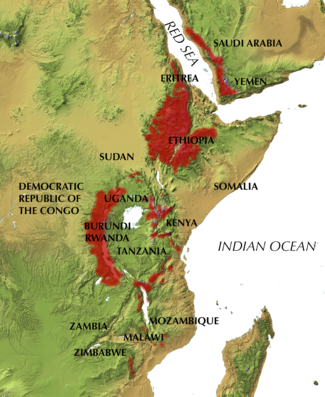Afromontane
This article needs additional citations for verification. (June 2012) |

The Afromontane regions are subregions of the Afrotropical realm, one of the Earth's eight biogeographic realms, covering the plant and animal species found in the mountains of Africa and the southern Arabian Peninsula. The Afromontane regions of Africa are discontinuous, separated from each other by lower-lying areas, and are sometimes referred to as the Afromontane archipelago, as their distribution is analogous to a series of sky islands.
Geography[]
Afromontane communities occur above 1,500–2,000 metres (4,900–6,600 ft) elevation near the equator, and as low as 300 metres (980 ft) elevation in the Knysna-Amatole montane forests of South Africa. Afromontane forests are generally cooler and more humid than the surrounding lowlands.
The Afromontane archipelago mostly follows the East African Rift from the Red Sea to Zimbabwe, with the largest areas in the Ethiopian Highlands, the Albertine Rift Mountains of Uganda, Rwanda, Burundi, Democratic Republic of the Congo, and Tanzania, and the Eastern Arc highlands of Kenya and Tanzania. Other Afromontane regions include the Drakensberg range of southern Africa, the Cameroon Highlands, and the Cameroon Line volcanoes, including Mount Cameroon, Bioko, and São Tomé.
Flora[]
Although some Afromontane enclaves are widely separated, they share a similar mix of plant species which are often distinct from the surrounding lowland regions. Podocarps, of genera Podocarpus and Afrocarpus, are a characteristic tree, along with Prunus africana, Hagenia abyssinica, Juniperus procera, and Olea spp.. In the higher mountains, the Afromontane forest or woodland zone transitions to a higher Afroalpine zone of grasslands, shrublands, or moorlands.
The plant families Curtisiaceae and Oliniaceae are Afromontane endemics and family Barbeyaceae is a near-endemic. The tree genera Afrocrania, Balthasaria, Curtisia, Ficalhoa, Hagenia, Kiggelaria, Leucosidea, Platypterocarpus, Trichocladus, Widdringtonia, and Xymalos are Afromontane endemics or near-endemics, as are the plant genera Ardisiandra, Cincinnobotrys, and Stapfiella.
Distribution[]

In South Africa, Afromontane forests cover only 0.5% of the country's land area. The Afromontane forests occur along the mountainous arc of the Drakensberg Range, from Limpopo Province in the northeast to the Western Cape Province in the southwest. The Afromontane forests generally occur in well-watered areas, including ravines and south-facing slopes. The Afromontane forests are intolerant of fire, and the frequent fires of the surrounding fynbos, savanna, and grassland limit the expansion of the forests. Despite their small area, the Afromontane forests of South Africa produce valuable timber, particularly the real yellowwood (Podocarpus latifolius), Outeniqua yellowwood (Afrocarpus falcatus), and stinkwood (Ocotea bullata).
Afromontane ecoregions[]
- Albertine Rift montane forests (Democratic Republic of the Congo, Burundi, Rwanda, Tanzania, Uganda)
- Cameroonian Highlands forests (Cameroon, Nigeria)
- East African montane forests (Kenya, South Sudan, Tanzania, Uganda)
- Eastern Arc forests (Tanzania, Kenya)
- Ethiopian montane forests (Djibouti, Eritrea, Ethiopia, Somalia, Sudan)
- Guinean montane forests (Guinea, Côte d'Ivoire, Liberia, Sierra Leone)
- Knysna-Amatole montane forests (South Africa)
- Southern Afrotemperate Forest (Western Cape Province of South Africa)
- Mount Cameroon and Bioko montane forests (Cameroon, Equatorial Guinea)
- Angolan montane forest-grassland mosaic (Angola)
- Angolan scarp savanna and woodlands (Angola)
- Drakensberg alti-montane grasslands and woodlands (Lesotho, South Africa)
- Drakensberg montane grasslands, woodlands and forests (Lesotho, South Africa, Swaziland)
- East African montane moorlands (Kenya, South Sudan, Tanzania, Uganda)
- Eastern Zimbabwe montane forest-grassland mosaic (Mozambique, Zimbabwe)
- Ethiopian montane grasslands and woodlands (Eritrea, Ethiopia)
- Ethiopian montane moorlands (Ethiopia)
- Highveld grasslands (Lesotho, South Africa)
- Jos Plateau forest-grassland mosaic (Nigeria)
- Maputaland-Pondoland bushland and thickets (Mozambique, South Africa, Swaziland)
- Southern Afrotemperate Forest (Western Cape Province of South Africa)
- Rwenzori-Virunga montane moorlands (Democratic Republic of the Congo, Rwanda, Uganda)
- South Malawi montane forest-grassland mosaic (Malawi, Mozambique)
- Southern Rift montane forest-grassland mosaic (Malawi, Tanzania)
- Deserts and xeric shrublands
- Southwestern Arabian montane woodlands (Saudi Arabia, Yemen)
References[]
- White, F. (1983). The vegetation of Africa: a descriptive memoir to accompany the UNESCO/AETFAT/UNSO vegetation map of Africa by F. White. UNESCO, Paris.
- Galley, C. & Linder, H. P. (2006) Geographical affinities of the Cape flora, South Africa. Journal of Biogeography 33 (2), 236–250.
External links[]
| Wikimedia Commons has media related to Afromontane. |
- Afromontane
- Afrotropical ecoregions
- Tropical and subtropical moist broadleaf forests
- Montane grasslands and shrublands
- Deserts and xeric shrublands
- Ecoregions of Africa
- Ecoregions of Saudi Arabia
- Ecoregions of Yemen
- Flora of Africa
- Flora of the Arabian Peninsula